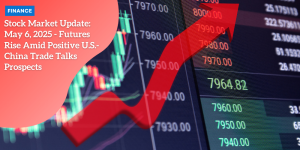Breaking Stock Market News: Tech Giants, Trade Shifts, and Market Trends You Can’t Miss Today

Market Overview: U.S. Stock Futures Trending Lower After Recent Gains
Mixed Trends After Three Winning Sessions
After three consecutive winning sessions, U.S. stock futures are showing signs of decline.
Anúncios
This setback comes at a time when easing tariff concerns initially gave markets a positive spin.
The easing of trade tensions had built optimism, but market dynamics remain unpredictable.
As of this morning, the Dow Jones Industrial Average futures are lower by 0.4%, while the S&P 500 and NASDAQ-100 futures are slightly down too after their recent gains.
Anúncios
Easing Tariff Concerns
Trade policies and tariffs have long been a source of uncertainty affecting market sentiment.
Recently, there has been progress on the trade front, particularly with China, leading to reduced tensions.
This initially bolstered investor confidence, but there’s still a cautious attitude in the market.
Anúncios
The reduced strain in trade relations indicates that while the impact might be positive, it is not creating an uninterrupted path of growth for U.S. stock futures.
Key Market Indicators
Bitcoin
The cryptocurrency market is often a reflection of broader financial sentiments.
Bitcoin is currently stable at around $94,000.
Not swaying much in either direction provides some consistency even when traditional markets fluctuate.
Gold and Oil
Gold and oil futures are experiencing a dip, both down by about 1%.
Gold is traditionally seen as a safe haven in times of market uncertainty, so its decline suggests that the easing tariff tensions had created a temporary window of reduced fear among investors.
However, the descent in gold indicates that this sentiment might not be solidified yet.
Similarly, the dipping oil prices reflect a recalibration in global supply and demand expectations.
Treasury Yields
On the other hand, Treasury yields are slightly lower at about 4.29%.
Lower yields often suggest a shift towards bonds as a safer investment compared to equities, especially in times of market volatility.
This hints at a mixed market sentiment where safety and caution are still prevalent.
The link between numerous factors like tariffs, market sentiments, and changes in global trade cannot be overstated.
These trends and market indicators provide investors with a roadmap to navigate the volatile landscape.
As we move forward, it’s essential to keep a close eye on these indicators and their subsequent ripple effects on the technology and manufacturing sectors.
Thus, the ongoing shifts in international trade landscapes will continue shaping investment strategies in the long term.
Alphabet’s Impressive Performance: Cloud and AI Driving Growth
Google Cloud’s Soaring Revenue
Alphabet, Google’s parent company, has been making waves in the stock market with significant growth, particularly in its cloud services.
In the first quarter of 2025, Google Cloud revenue experienced an impressive 28% year-over-year increase, reaching $12.3 billion.
This surge highlights Google’s robust position in the competitive cloud services sector, where it continues to challenge other tech giants like Amazon Web Services and Microsoft Azure.
The Role of AI in Boosting User Engagement
Alphabet’s success isn’t confined to its cloud division.
The company has also seen notable growth in its AI-powered features.
One standout example is Google’s AI Overviews, a powerful tool integrated into its search engine.
With 1.5 billion monthly users, AI Overviews has driven substantial user engagement by providing more intuitive and relevant search results.
This innovative feature has become instrumental in enhancing the overall user experience, thereby increasing Alphabet’s revenue from its search operations.
Stock Market Reaction
Investors have responded positively to Alphabet’s impressive performance.
The company’s shares surged by 4% in premarket trading following the announcement of its strong revenue growth.
This uptick underscores the market’s confidence in Alphabet’s ability to leverage its cloud and AI capabilities for sustained growth.
Diversification and Future Prospects
Alphabet’s strategy of diversification is paying off.
By expanding its footprint in cloud services and integrating AI across its platforms, the company is not only boosting its current growth but also setting the stage for future expansion.
This strategic approach mitigates risks associated with over-reliance on a single revenue stream and positions Alphabet well for adapting to evolving market dynamics.
As Alphabet continues to innovate and expand its service offerings, investors and market watchers will be keen to see how these developments influence the company’s trajectory amid broader market trends.

Intel’s Struggles: Weak Outlook and Workforce Reductions
Disappointing Revenue Forecast
Intel is facing a tough road ahead as the company recently issued a weak revenue forecast for 2025.
The tech giant anticipates a potential 20% drop in projected revenue, largely due to the diminishing demand for personal computers and data centers.
This decline has led investors to question Intel’s ability to maintain its market position in an increasingly competitive landscape.
Consequently, Intel’s shares plunged by 7% in premarket trading, reflecting the market’s negative sentiment towards the company’s future prospects.
CEO Lip-Bu Tan’s Candid Admission
Intel’s CEO, Lip-Bu Tan, has been transparent about the challenges that the company faces.
In a recent statement, Tan acknowledged that there were no quick fixes to Intel’s problems.
He emphasized the need for a realistic approach to overcoming these obstacles, noting that it will take time and strategic effort to regain market share and drive sustainable growth.
This candid admission highlights the gravity of Intel’s situation and sets an expectation for a prolonged period of restructuring and recovery efforts.
Planned Workforce Reductions
As part of its restructuring strategy, Intel plans to implement significant workforce reductions.
The company estimates that up to 15,000 employees could be laid off in an effort to mitigate losses and streamline operations.
This move is seen as essential for realigning Intel’s focus and improving its financial health in the long term.
However, it also raises concerns about the impact on employee morale and the potential loss of crucial talent.
Transitioning Challenges
These developments at Intel illustrate the shifting dynamics within the tech industry, where companies must continuously adapt to evolving market conditions and technological advancements.
Investors are keeping a close eye on Intel’s performance and restructuring efforts, as they look to reassess their investment strategies in light of these changes.
Overall, Intel’s struggles highlight the inherent volatility and challenges that tech companies face in maintaining their competitive edge and financial stability.
Apple’s Manufacturing Shift: From China to India
Apple’s decision to relocate all U.S.-bound iPhone production from China to India by 2026 marks a strategic pivot with far-reaching implications.
The plan underscores Apple’s adaptive strategies in response to the global trade environment and is intended to ensure supply chain stability and cost efficiency.
Doubling Production Capacity in India
As part of this shift, Apple aims to double its production capacity in India.
Given the favorable business environment and sizable population, India presents a promising market for Apple’s future growth.
Foxconn and Wistron, two of Apple’s top manufacturing partners, are already investing heavily in India to facilitate this transition.
Foxconn, for instance, committed $1 billion to develop its production capabilities, reflecting the scale and seriousness of this initiative.
Such investments are not merely tactical but also signify a long-term commitment to integrating India into Apple’s core manufacturing framework.
Impact on Global Supply Chains
This relocation will undoubtedly alter the dynamics of global supply chains.
Currently, Apple is highly dependent on Chinese factories for most of its production needs.
Shifting to India might initially pose logistical challenges, but it is likely to yield benefits such as reduced tariffs and lower labor costs.
In the wake of this move, other tech companies might also consider diversifying their manufacturing bases to offset similar risks.
Evolving U.S.-China Trade Relations
The shift could have substantial implications for U.S.-China trade relations.
By reducing its manufacturing footprint in China, Apple is positioned to minimize its exposure to trade tensions between the two economic powers.
This move reflects a broader trend in which multinational corporations are re-evaluating their reliance on any single geographic region for critical production to mitigate geopolitical risks.
These strategic decisions will inevitably influence investor sentiment and portfolio strategies.
By opting to invest in countries with growing markets and stable political climates, companies like Apple are paving the way for a more resilient global economy.
| Scenario | Before (Pre-Tension) | After (Post-Tension) |
|---|---|---|
| 📉 Share Value | Stable, steady growth | 6% decline due to weaker-than-expected results |
| 📊 Revenue | On-target sales growth | $2.41 billion in sales, missing projections |
| 📝 Full-Year Outlook | Positive forecasts for the year | Withdrawn due to macroeconomic uncertainty |
| 🌍 Global Trade | Steady trade agreements | Tensions and unpredictable tariffs impacting growth |
| 📦 Supply Chain | Efficient, stable global operations | Vulnerable due to disrupted international supply chains |
What These Developments Mean for Investors
Key Takeaways from Today’s Market Movements
Today’s market updates reveal critical insights for investors navigating the current economic landscape.
U.S. stock futures are trending lower after three consecutive winning sessions, reflecting ongoing market adjustments.
The easing of tariff concerns offers a glimmer of hope, but the effects on market sentiment remain mixed.
Important indicators like Bitcoin, gold, oil, and Treasury yields suggest varied investor reactions, making it crucial to stay informed on these metrics.
Technology and Manufacturing Sector Shifts
The significant news surrounding Alphabet, Intel, and Apple hints at substantial shifts in the tech and manufacturing sectors.
Alphabet’s impressive performance underscores the increasing importance of cloud services and AI technologies.
With a 28% year-over-year revenue increase in cloud services and 1.5 billion monthly users engaging with AI Overviews, Alphabet’s growth trajectory seems firmly secured, influencing investor strategies towards tech stocks.
On the other hand, Intel’s struggles highlight the volatility within the tech sector.
A 7% drop in shares following a poor revenue forecast signifies potential risks.
CEO Lip-Bu Tan’s acknowledgment of “no quick fixes” suggests a turbulent road ahead, prompting investors to exercise caution with semiconductor stocks.
Apple’s strategic shift from China to India signifies a major transition in global manufacturing dynamics.
By relocating all U.S.-bound iPhone production to India by 2026 and doubling production capacity, Apple aims to mitigate risks related to U.S.-China trade tensions.
This move could inspire other tech companies to diversify their manufacturing bases, creating ripple effects across global supply chains.
Potential Long-Term Implications
The evolving international trade landscape impacts long-term investment strategies significantly.
Skechers’ recent setback, marked by a 6% decline in share value and withdrawal of its full-year outlook citing macroeconomic uncertainty, exemplifies how trade policies affect consumer goods companies.
Investors should closely monitor such shifts in trade policies and their ramifications on market performance.
For tech stocks, the rise of AI and cloud services, coupled with manufacturing relocations, indicates transforming sectors that demand agile investment strategies.
Diversification across regions and technological advancements remain key considerations for safeguarding investments against potential market volatility.
As uncertainties continue to shape global trade and market dynamics, staying informed and adaptable will be vital for investors looking to navigate these complex terrains successfully.
Stay tuned for more insights and updates on how these developments will influence future market trends and investor strategies.





